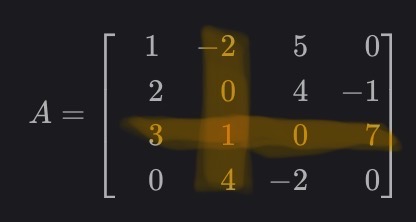Linear Algebra - 3.1 Introduction to Determinants
용어 정리
- determinant (행렬식)
- cofactor (여인수)
- cofactor expansion (여인수 전개)
Determinant - 행렬식
- 역행렬이 아닌 이상 우리는 주로 augmented matrix 를 조합하여 직사각행렬에 대한 계산을 위주로 했었다. 하지만 행렬식 단계에서는 정방행렬에 관련된 내용들이 주이다. 특히 행렬식이 필요한 이유는 여럿 있지만 가장 큰 이유중 한 가지는 Eigen Value (고유값) 때문이다.
- $2 \times 2$ Matrix
- 2장에서 배운 것을 복습하면 $2 \times 2$ 행렬에서의 determinant 가 nonzero 이면 invertible 이다.
$3 \times 3$ invertible matrix
- $2 \times 2$ 행렬의 determinant 를 구하는 것은 비교적 쉽지만, $3 \times 3$ 행렬 부터 determinant 를 구하는 것은 아주 복잡해진다.
- determinant 가 0이 아닌 것의 의미는 모든 row 에 pivot이 존재한다는 의미이다. 따라서 row reduction 을 진행하고 모든 pivot이 nonzero 임을 확인하면 된다.
- 여기서 $\Delta$ 는 다음과 같다.
- $\Delta = a_{11}a_{22}a_{33} + a_{12}a_{23}a_{31} + a_{13}a_{21}a_{32} - a_{11}a_{23}a_{32} - a_{12}a_{21}a_{33} - a_{13}a_{22}a_{31}$
$A$ 가 invertible 이므로, $\Delta$ 는 nonzero 이어야만 한다.
- $2 \times 2$ matrix 에서 determinant 는 아래와 같으므로 $\Delta$ 를 다음과 같이 표기할 수 있다.
$det A = a_{11}a_{22} - a_{12}a_{21}$
$\Delta = a_{11} \cdot det A_{11} - a_{12} \cdot det A_{12} + a_{13} \cdot det A_{13}$
- 여기서 예시로 $A_13$ 은 1번째 row 와 3번째 column 을 제외한 요소들을 의미한다.
- $A$ 가 위와 같이 주어졌을때, $A_{32}$ 는 다음과 같이 표기가 가능하다.
- 3번째 row 와 2번째 column 을 제거하여 남은 요소들을 행렬로 표현해주면 다음과 같다.
For $n \ge 2$ , the determinant of an $n \times n$ matrix $A = [a_{ij}]$ is the sum of $n$ terms of the form $\mp a_{ij}$ det $A_{ij}$ , with plus and minus signs alternating, where the entries $a_{11}, a_{12}, \dots , a_{1n}$ are from the first row of $A$ . In symbols,
$det A = a_{11} \, det A_{11} - a_{12} \, det A_{12} + \dots + (-1)^{1 + n} \, a_{1n} \, det A_{1n} $
$ = \sum\limits_{j=1}^n (-1)^{1 + j} \, a_{1j} \, det A_{1j} $
- 위 시그마 식은 determinant의 정의이다.
determinant 예제
- 다음과 같이 A 행렬이 주어졌을 때 determinant를 구하라.
- determinant 를 다음과 같이 간단히 표현이 가능하다.
Cofactor - 여인수
- cofactor 를 이용해서 determinant를 여러가지 형태로 표현할 수 있다.
$A = [a_{ij}] , $ the $(i, j)$-cofactor of $A$ is the number $C_{ij}$ given
$C_{ij} = (-1)^{i + j} \, det A_{ij}$
$det A = a_{11}C_{11} + a_{12}C_{12} + \dots + a_{1n}C_{1n}$
이를 cofactor expansion (여인수 전개) 라고 한다.
cofactor 의 부호는 이 식으로 결정되며 $(-1)^{i + j}$ 다음과 같은 규칙을 지닌다.
Theorem1.
The determinant of an $n \times n$ matrix $A$ can be computed by a cofactor expansion across any row or down any column. The expansion across the $i$ th row using the cofactors in here is
$ det A = a_{i1}C_{i1} + a_{i2}C_{i2} + \dots + a_{in}C_{in}$
The cofactor expansion down the $j$ th column is
$ det A = a_{1j}C_{1j} + a_{2j}C_{2j} + \dots + a_{nj}C_{nj}$
- cofactor expansion 을 이용하면 임의의 row, column 을 선택하여 determinant 를 표현할 수 있다. -> 어떤 cofactor 를 이용하더라도 결과는 동일하다.
- cofactor expansion 을 하기 위해서 zero entry 가 많은 row, column 을 기준으로 설정하면 계산이 단순해진다.
cofactor 예제
- A 가 주어졌을 때, det A 를 cofactor expansion 을 사용해서 구하라.
$ A = \begin{bmatrix} \phantom{-}1 & \phantom{-}5 & \phantom{-}0 \\ \phantom{-}2 & \phantom{-}4 & -1 \\ \phantom{-}0 & -2 & \phantom{-}0 \end{bmatrix} $
$ det A = a_{31}C_{31} + a_{32}C_{32} + a_{33}C_{33} $
$ = (-1)^{3+1} \, a_{31} \, det A_{31} + (-1)^{3+2} \, a_{32} \, det A_{32} + (-1)^{3+2} \, a_{32} \, det A_{32} + (-1)^{3+3} \, a_{33} \, det A_{33} $
$ = 0 \begin{vmatrix} \phantom{-}5 & \phantom{-}0 \\ \phantom{-}4 & -1 \end{vmatrix} - (-2) \begin{vmatrix} \phantom{-}1 & \phantom{-}0 \\ \phantom{-}2 & -1 \end{vmatrix} + 0 \begin{vmatrix} 1 & 5 \\ 2 & 4 \end{vmatrix} $
$ = 0 + 2(-1) + 0 = -2 $
- A 행렬의 determinant 를 구해라
- 0이 많이 구성되어 있는 matrix 는 다음과 같이 cofactor expansion 을 사용할 수 있다.
$ A = \begin{bmatrix} \phantom{-}3 & -7 & \phantom{-}8 & \phantom{-}9 & -6 \\ \phantom{-}0 & \phantom{-}2 & -5 & \phantom{-}7 & 3 \\ \phantom{-}0 & \phantom{-}0 & \phantom{-}1 & \phantom{-}5 & \phantom{-}0 \\ \phantom{-}0 & \phantom{-}0 & \phantom{-}2 & \phantom{-}4 & -1 \\ \phantom{-}0 & \phantom{-}0 & \phantom{-}0 & -2 & \phantom{-}0 \end{bmatrix} $
- first column $A_{11}$ 에 0이 제일 많으므로 이를 기준으로 cofactor expansion 을 사용한다.
$ det A = 3 \cdot \begin{vmatrix} \phantom{-}2 & -5 & \phantom{-}7 & \phantom{-}3 \\ \phantom{-}0 & \phantom{-}1 & \phantom{-}5 & \phantom{-}0 \\ \phantom{-}0 & \phantom{-}2 & \phantom{-}4 & -1 \\ \phantom{-}0 & \phantom{-}0 & -2 & \phantom{-}0 \end{vmatrix} + 0 \cdot C_{21} + 0 \cdot C_{31} + 0 \cdot C_{41} + 0 \cdot C_{51} $
- 또 다시 first column 이 0이 제일 많으므로 이를 이용한다.
$ det A = 3 \cdot 2 \cdot \begin{vmatrix} \phantom{-}1 & \phantom{-}5 & \phantom{-}0 \\ \phantom{-}2 & \phantom{-}4 & -1 \\ \phantom{-}0 & -2 & \phantom{-}0 \end{vmatrix} $
$ det A = 3 \cdot 2 \cdot (-2) = -12 $
- 이 처럼 0 이 많은 row 나 column을 이용하면 아무리 복잡한 행렬이더라도 cofactor expansion 으로 손으로 풀 수 있다.
Theorem2.
If $A$ is triangular matrix, then det $A$ is the product of the entries on the main diagonal of $A$ .
- $A$ 가 triangular matrix (삼각행렬, upper or lower) 이면 det $A$ 는 $A$ 의 diagonal term 을 곱한 것이다.
$ \begin{pmatrix} a_{11} & 0 & 0 \\ a_{21} & a_{22} & 0 \\ a_{31} & a_{32} & a_{33} \end{pmatrix} $ : Lower triangular matrix
$ \begin{pmatrix} a_{11} & a_{12} & a_{13} \\ 0 & a_{22} & a_{23} \\ 0 & 0 & a_{33} \end{pmatrix} $ : Upper triangular matrix
- cofactor expansion 을 이용하여 determinant 를 구하는 것은 매우 복잡한 계산을 해야한다. $n!$ 만큼의 연산이 소요된다.
- 따라서 determinant 를 구하기 위해 cofactor expansion 을 사용하여 계산하는 것은 매우 무모한짓이다.


